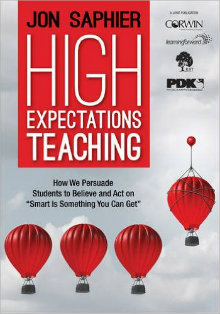Helping Students Believe They Can Learn
High Expectations Teaching: How We Persuade Students to Believe and Act on “Smart Is Something You Can Get”
By Jon Saphier
(Corwin, 2017 – Learn more)

I requested the book High Expectations Teaching by Jon Saphier because at our school growth mindset has become the “buzzword” of the moment. The book’s blurb mentioned that the book focuses on ways to get students to have a growth mindset. I am really glad that I chose this book!
The chapters in High Expectations Teaching are:
The History of Intelligence
- Malleable Intelligence: The Evidence – Attribution Retraining and the Growth Mindset
- Verbal Behavior in Nine Arenas of Classroom Life
- Regular Classroom Mechanisms for Generating Student Agency
- No Secrets Instructional Strategies That Support Student Agency
- Teaching Effective Effort
- Choices That Generate Agency: Voice, Ownership, and Influence
- Schoolwide Policies and Procedures
- Conclusion
Each chapter in Jon Saphier’s book contains barcode scanner links to mentor teaching example videos which connect to the content in the chapter. The link to video is also given, if you do not have the barcode scanner app. I found this to be really helpful if you are someone who likes to watch a concept in action after reading about it.
Concepts to use now
The author breaks down the chapters with “50 Ways to Get Students to Believe in Themselves or How to Do Attribution Retraining.” A lot of these concepts were ones I was familiar with. Some I might have done some of them early on in my teaching and haven’t lately. Others I have been doing and just need to tweak or be more conscious of (like extended wait time for answers or re-testing until students pass a quiz).
Others were concepts I really want to try for the first time, such as more deliberate goal setting (there is a simple template provided in the appendix) and the “Power of Yet.” There are many ideas offered, which makes the book appealing to a broad audience of educators from all grade levels.
The importance of relationships
Saphier spends a lot of time reminding educators that we need to build relationships with our students and let them know that we believe they can learn. When students say they can’t do something, remind them that they just don’t know how to do it “yet.” We should guide our students as we encourage more risk taking. Students need to know it is okay and a good thing to make mistakes. We should praise, but be specific in our praise.
Teachers need to give students specific feedback, without judgment, on their work, and have students set goals that are measurable and achievable. This is information we have all heard as educators, but it’s a nice reminder with helpful examples given by the author that can help us move from hearing to doing.
Additional resources
In addition to the abundance of information offered in the chapters, Saphier gives the reader various grade level case studies to read, take-away ideas in appendix A, common planning time activities in appendix B, hierarchy of interventions in appendix C, goal setting experiments in appendix D, a kindergarten teacher’s log of teaching the growth mindset to students and parents in appendix E, and effort books for all grade levels in appendix F.
This book is a good read for a teacher looking to better themselves professionally, as I am, to learn about how to impart the growth mindset to students, or for book study for a PLC or staff development. I believe administrators would benefit from reading this book and applying what they learn to their practice, as well as their staff, as it does contain information for school policies and procedures as well as information as to how best run PLC’s with growth mindset in mind.
Kathee Lamberies is in her 13th year of teaching. Currently, she teaches sixth grade English and social studies. She previously taught first, second, fourth and fifth grades and has a Bachelor’s and a Master’s from Grand Valley State University.


































